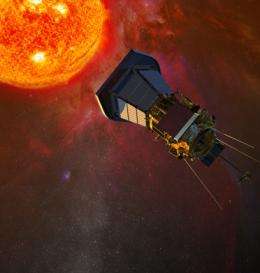NRL's wide-field imager selected for Solar Probe Plus mission

NASA has chosen the Naval Research Laboratory's Wide-field Imager to be part of the Solar Probe Plus mission slated for launch no later than 2018. The Solar Probe Plus, a small car-sized spacecraft will plunge directly into the sun's atmosphere approximately four million miles from our star's surface. It will explore a region no other spacecraft ever has encountered in an effort to unlock the sun's biggest mysteries.
For decades, scientists have known that the corona, or the outer atmosphere, is several hundreds of times hotter than the visible solar surface and that the solar wind accelerates up to supersonic speeds as it travels through the corona. In the Solar Probe Plus mission, scientists hope to find answers to the questions: why is the solar corona so much hotter than the photosphere? And how is the solar wind accelerated? The answers to these questions can be obtained only through in-situ measurements of the solar wind down in the corona.
NRL's Wide-field Imager for Solar Probe (WISPR) is one of five science investigations selected by NASA for this mission. It is the only optical investigation because the solar environment is so hot the instruments need to be tucked behind a heat shield. NRL's Dr. Russell Howard, the principal investigator, says, "This is an extremely exciting mission - no other spacecraft has ever gone this close - it is like the early voyagers of the earth, we don't really know what to expect, but we know, whatever it is, it is going to be spectacular."
The imager is a telescope, which looks off to the side of the heat shield, and will make 2-D images of the sun's corona as the spacecraft flies through. But like a medical CAT scan, the orbit of the spacecraft through the corona will enable 3-D images and a determination of the 3-D structure of the corona. The experiment actually will see the solar wind and provide 3-D images of clouds and shocks as they approach and pass the spacecraft. "We'll be flying through the structures that we've only seen from 100 million miles away. We'll be able to see all the phenomena (mass ejections, streamers, shocks, comets, and dust) up close. Other instruments will be able to measure the magnetic and electric fields and the plasma itself," explains Howard. This investigation complements instruments on the spacecraft by providing direct measurements of the plasma far away as well as near the spacecraft - the same plasma the other instruments sample.
The other four investigations chosen for the Solar Probe Plus mission include:
• The Solar Wind Electrons Alphas and Protons Investigation will specifically count the most abundant particles in the solar wind -- electrons, protons and helium ions -- and measure their properties. The investigation also is designed to catch some of the particles in a special cup for direct analysis. (Smithsonian Astrophysical Observatory in Cambridge, Massachusetts)
• The Fields Experiment will make direct measurements of electric and magnetic fields, radio emissions, and shock waves that course through the sun's atmospheric plasma. The experiment also serves as a giant dust detector, registering voltage signatures when specks of space dust hit the spacecraft's antenna. (University of California Space Sciences Laboratory in Berkeley, California)
• The Integrated Science Investigation of the Sun consists of two instruments that will take an inventory of elements in the sun's atmosphere using a mass spectrometer to weigh and sort ions in the vicinity of the spacecraft. (Southwest Research Institute in San Antonio, Texas)
• The Heliospheric Origins with Solar Probe Plus is led by Dr. Marco Velli who is the mission's observatory scientist, responsible for overseeing assembly of the spacecraft. He will ensure adjacent instruments do not interfere with one another and guide the overall science investigations after the probe enters the sun's atmosphere. (NASA's Jet Propulsion Laboratory in Pasadena, California)
The Solar Probe Plus mission is part of NASA's Living with a Star Program. The program is designed to understand aspects of the sun and Earth's space environment that affect life and society. The program is managed by NASA'S Goddard Space Flight Center in Greenbelt, Maryland, with oversight from NASA's Science Mission Directorate's Heliophysics Division. The Johns Hopkins University Applied Physics Laboratory in Laurel, Maryland, is the prime contractor for the spacecraft.
Provided by U.S. Navel Research Lab



















